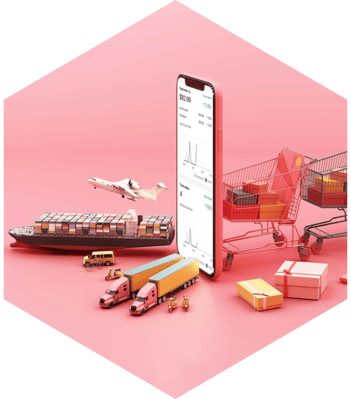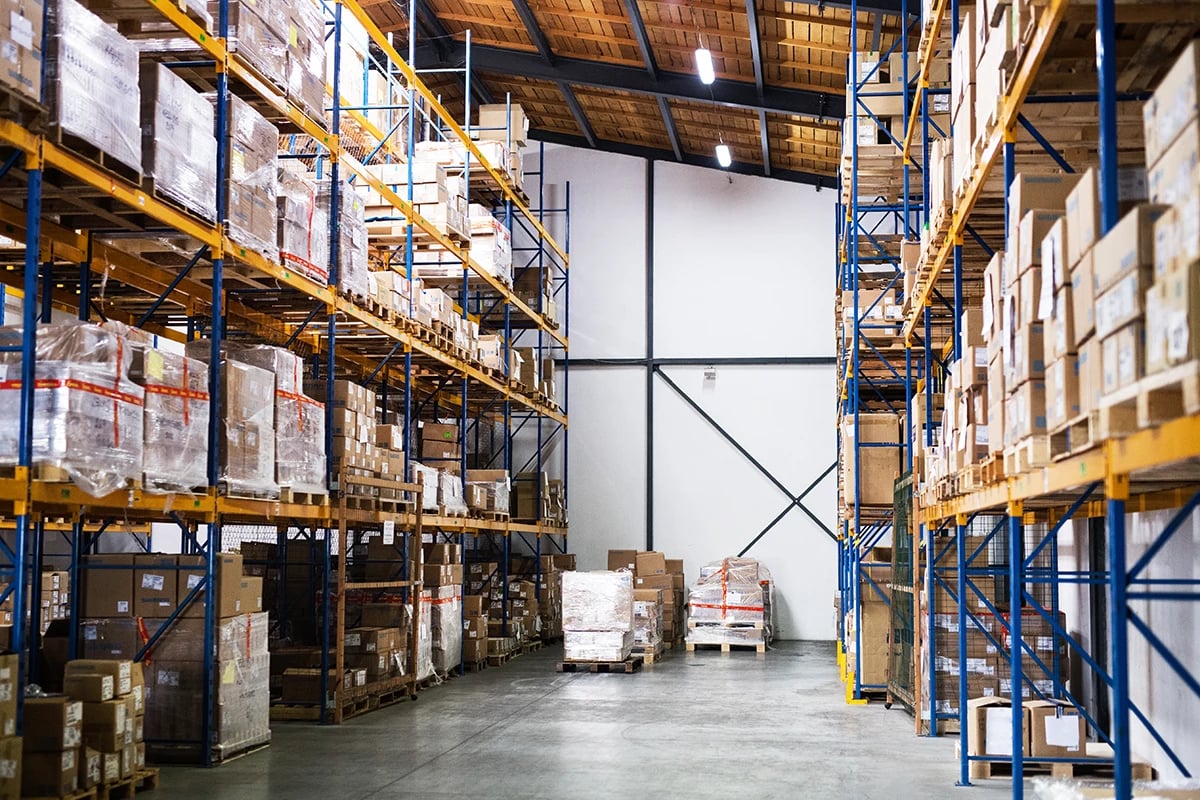eCommerce
Order fulfillment

Tailored order fulfillment strategies
Any savvy eCommerce owner knows all too well that, for their store to be a continued success, order fulfillment processes must be front of mind. Only with a solid, efficient, and cost-effective order fulfillment strategy, in fact, will any online store succeed at delivering customers’ products quickly, safely, and productively.
A well-functioning order fulfillment process generates happier customers – and happier customers, as we all know, are much more likely both to return to your brand and to recommend it to everyone they know, boosting your sales as a result.
This guide delves deep into five specific product categories – electronics, cosmetics, supplements, sporting goods, and clothing– to describe their peculiarities and provide insights into what kind of order fulfillment solutions and strategies would be optimal.

Understanding order fulfillment
Order fulfillment is the process by which a sales merchant delivers a product to a customer as specified at the time of order. It's a crucial aspect of supply chain management that involves delivering goods as agreed upon sale. An effective order fulfillment process enables companies to sell more products and foster repeat business.
Let's explore the standard order fulfillment process to understand how it underpins the success of different product categories.
Request a quote
The standard order fulfillment process
In general, a traditional order fulfillment process occurs in one
or several distribution centers and is formed of around eight different
steps – we will describe each one of them in detail below.
Receiving Inventory
Inventory storage
Order processing
Picking
Packing
Shipping
Delivery
Returns
Order fulfillment for cosmetics
This product category includes everything from basic beauty and hygiene to high-end, luxury make-up, perfumes, and skin and body care products. One of the most popular industries out there, the cosmetics sector has seen even higher demand during and immediately after the coronavirus pandemic outbreak.

Product category insights
The online cosmetics sector displays unique characteristics, including:
- A fast-growing, yet still relatively young, online market
- The possibility to sell products online that are not available in brick-and-mortar shops
- Lower, or at least more competitive, prices compared to most physical stores.
Cosmetics fulfillment: make pick, pack, and ship your competitive advantage
Logistics can be your competitive advantage if you manage a cosmetics eCommerce business. To achieve this, it’s vital that you look at how you package your products. For example, if you are an organic skincare brand, opt for eco-friendly packaging materials as well as delivery options made through carriers that are committed to slashing their CO2 emissions.
Just like most other eCommerce sectors, the cosmetics industry also hugely benefits from speedy deliveries. This can be done by optimizing your logistics processes and choosing to ship your goods from the location that is closest to your customers.
Order fulfillment solutions for your eCommerce store
OGOship has a global network of warehouses allowing you to optimize your logistics chain. All our customers have the option to store their goods in multiple warehouses at the same time. This enables you to offer local-like, low-C02 deliveries your customers love.
Order fulfillment for supplements
Health and wellness are one of those eCommerce segments that are growing rapidly. It is also a very competitive segment, with new products and new online stores emerging and entering the market.

Product category insights
- There is great potential with subscription-based operational logic for many supplements, vitamins, and personal care products that eCommerce businesses can utilize to ensure a steady revenue flow.
- eCommerce merchants need to pay special attention to regulatory issues.
- Special regulatory considerations need to be taken into concern when it comes to international shipping.
Order fulfillment – a path to success for supplements, vitamins, and personal care products
Order fulfillment for supplements must pay particular attention to accuracy. For some products, there might be specific hygiene or temperature requirements. With this product category, a best practice is to rotate.
With supplements and vitamins, eCommerce merchants have to pay interest in shipping fees and costs. One way to offer faster, more affordable shipping options to your customers is by distributing inventory across multiple fulfillment centers. In Europe, for example, a warehouse in Central Europe could cater to the customer base close to Germany and another fulfillment center in the Nordics.
Use branded packaging to ensure your name and logo are present when the customer receives the order.
How can OGOship benefit you?
OGOship offers the option to customize packaging as well as distribute inventory to multiple order fulfillment hubs for all customers. This provides you with sustainable, fast, and cost-effective shipping.
Order fulfillment for sporting and fitness products
Like eCommerce overall, also sporting and fitness products are high in demand. And this product category is also a very competitive one.

Product category insights
- Sporting goods are somewhat special from a warehousing and order fulfillment point of view since they may come in whatever shapes, sizes, and weights.
- The seasonal variation may be high, and e-commerce merchants need to be able to scale their capacity to meet peak sales seasons.
- Pick and pack accuracy, and careful packaging is important to avoid the goods being damaged.
Sporting and fitness products order fulfillment to your advantage
OGOship has extensive experience working together with many sporting and fitness brands. Our customers sell a variety of different kinds of products, for example, related to gamified physical activity and yoga, to name a few.
Gain competitive advantage with OGOship
We provide fast shipping to the whole of Europe. With our services, you can optimize your eCommerce logistics and store your products strategically in optimal order fulfillment centers. This allows you to gain fast shipments with lower costs.
Order fulfillment for electronics
TV sets, mobile devices, smart home tools, and many more media and digital products are at the heart of the consumer electronics sector. An extremely dynamic, competitive, and fast-paced industry, this product category can hugely benefit from a solid order fulfillment process.

Product category insights
When discussing the category of consumer electronics, these are the main things that are worth bearing in mind:
- Electronics is a very fast-paced, ever-evolving product category for eCommerce.
- Consumer media and electronics are also one of the most mature segments in eCommerce.
- Typically, consumers spend some time doing online research and then buying offline, but more and more people are turning to online stores, too.
- The sales of electronics products are increasingly accompanied by other services, such as the installation of the product and/or its maintenance and repair.
- One of the crucial factors in determining a purchase in this segment is other customers’ reviews and experiences with the product.
Electronics fulfillment: considerations for pick, pack, and ship
Many consumer electronics products are very fragile and valuable, which means brands need to apply some extra security and quality measures throughout the entire supply chain.
To begin with, you or your selected fulfillment partner will need to know how, exactly, the items should be packaged, as well as be aware of whether they need to be stored under particular conditions (think about, for example, temperature or humidity levels). It’s also essential to comply with any regulatory aspects related to the shipment of those products, to avoid fines or other legal complications.
OGOship as your order fulfillment partner
OGOship has done order fulfillment for various electronics brands for years. Our specialists are happy to tell you more about how we can ensure your products are packed securely and shipped fast.
Order fulfillment for clothing
This market segment specializes in the distribution of clothing apparel, from underwear down to outdoor and sports-related gear. It may also include footwear and accessories, and it usually encompasses clothing items for women, men, and children.

Product category insights
The fashion industry differentiates itself from other product categories in the following:
- It is one of the oldest-established online retail sectors.
- Typical distribution channels include merchants that stock and distribute a range of different clothing types and brands, such as Zalando, Boozt or OnBuy.
- The standard lifecycle of products is rather short, with items changing every new season as with new trends emerging at a fast pace (and others disappearing just as rapidly).
- The amount of returned products is much higher compared to other product categories.
Clothing fulfillment: the key takeaways
If you want to make logistics the differentiating and winning factor for your clothing store, then we have some useful bits of advice for you below.
Focus on fast deliveries
Just like the fashion industry itself tends to operate at a very swift pace, so do its warehousing and logistics processes. Customers want and expect their clothing items to be delivered quickly, therefore you will need to provide that level of speed with all your online orders.
Implement an accurate pick-and-pack process
Due to high pick-and-pack demands, fashion brands have very little room for mistakes on any order they receive. This makes it essential for your online clothing business to have a process in place that always ensures that the right item (think size, color, type, number of items, and so on) gets shipped to the right customer, every single time.
Be savvy about seasonality
Do you have a strategy to manage seasonality? For example, with end-of-year sales often increasing exponentially, you might need to hire more warehouse and logistics resources, to keep up with the higher demand while still delivering exceptional order fulfillment services.
Don’t forget about returns
The fashion industry is also characterized by a much higher turnover of items compared to other sectors, which makes it vital for your online clothing brand to keep returns front of mind. Most eCommerce retailers want to offer free or very convenient returns, but you must always remember that returns are never, in fact, totally free for you: you will still need to pay for delivery. This also poses a serious issue from an environmental point of view, as moving items back and forth will contribute to increasing your carbon footprint at a time when you should be doing the exact opposite. So, instead of exclusively managing returns, think about how to avoid returns, or minimize them as much as possible. For example, offer much more detailed product descriptions on your online store, perhaps add a video too, and incorporate a sizing guide as well as customer reviews that mention sizing and fitting.
Want to know more about our returns portal?
Connect with our experts today, and let them guide you on how our solution enables your growth.
Learn how we can optimize your eCommerce fulfillments
How easy is it for you to scale your operations?
Even after you have found a robust, reliable order fulfillment strategy, how can you ensure that this remains just as successful if you are in the process of expanding your operations?
For many eCommerce businesses, it has taken a relatively long time to tweak the order fulfillment processes to perfection, but this all may change once you have set your sights on different geographies, customers, and perhaps even currencies.
This is where a third-party logistics (3PL) provider should be able to help. 3PLs are companies that specialize in providing eCommerce merchants with essential supply chain management services, including order fulfillment.
By working with a 3PL provider like OGOship, online retail stores can achieve the following benefits:
Strengthen your profit margins
When an online retailer begins to notice that they are fulfilling more than 10 to 20 orders every day, then that’s the ideal time to consider partnering with a 3PL. By doing so, companies can protect and reinforce their profit margins thanks to lower costs associated, particularly, with manual labor. In parallel, teaming up with a 3PL can also serve as a tool to start expanding internationally quickly, while still following a solid and efficient order fulfillment process.
Scale up your storage and inventory space
Cut your costs
Excel at order fulfillment wherever you operate, with OGOship
- High Return Rates: Affecting the bottom line, especially in countries like Germany with a 53% return rate.
- Complex Return Policies: Deter customers and affect customer retention.
- Management Overheads: Resource and time-intensive processes from requests to restocking.
- Cross-Border Returns: A complex challenge within the EU, often hindering a seamless customer experience.
Talk with our eCommerce experts
Ready to learn more? Our experts will answer any questions you may have on how to get started, what the key features are, and which warehouse locations bring your e-commerce business the maximum benefit.

